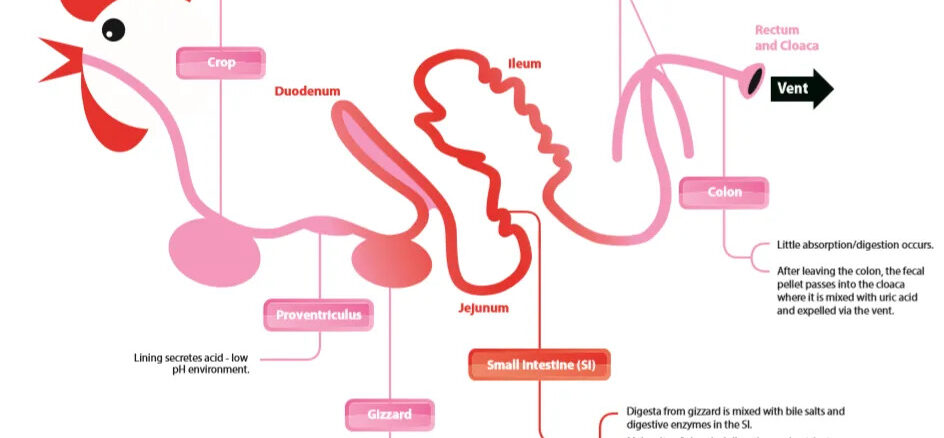Gut Health: Reduce Pathogenic Bacteria
Some nutritional strategies can have an antibacterial activity, do you want to know which ones?
The reduction of the burden of pathogenic bacteria is an objective that must be addressed through different strategies, such as the use of drugs in certain cases, proper cleaning and handling methods, and tailored nutrition aimed at reducing their presence and strengthening gut health.
A good nutritional strategy to reduce pathogens may be to reduce protein fermentation, since the presence of undigested protein in the digesta promotes the growth of bacteria that ferment it (such as E.coli sp., Proteus sp., and Clostridia sp.). Likewise, there is an increase in the colonic concentration of potentially toxic compounds for the intestinal mucosa, such as NH3, biogenic amines (histamine) and hydrogen sulfide. To reduce these pathogens, especially in post-weaning phase (due to the low digestion capacity of animals at this age), diets should be formulated with low protein levels (supplementing if necessary with synthetic amino acids), to facilitate digestion and avoid the presence of undigested protein in the digest. Otherwise, fermentable carbohydrates (such as wheat bran or beet pulp) can be provided, to reduce the concentration in the digesta of metabolites derived from protein fermentation, and increase the lactobacillus:enterobacteria ratio (Pérez, 2013).
Another strategy would be to facilitate the transit of digesta, and the stabilization of the intestinal microbiota, by administering insoluble fiber (Molist et al., 2012) such as cereal husks. Alternatively, exogenous enzymes could be incorporated in order to decrease the viscosity of the diet, since it has been reported that high viscosity can enhance the presence of pathogens (Kiarie et al., 2013).
Regarding feed additives, probiotics stand out. They have been described to reduce the presence of pathogens directly through competitive exclusion (competing with the pathogen to bind in the same receptor of the intestinal epithelium), engaging pathogens through receptors analogous to those of the intestinal epithelium (preventing its union to the epithelium) or producing bacteriocins with antimicrobial effect (Nig et al.2009). Moreover, indirect mechanisms have also been reported, such as increased production of organic acids in the intestine by fermenting carbohydrates from the diet, increasing a favorable microbiota or potentiating the immune response of the pig (Oelschlaeger et al. 2010). However, a recent review of the use of probiotics in experimental infections in post-weaning piglets, suggests that their effects are highly influenced by the strain and the context in which they are used (Barba-Vidal et al., 2018). Therefore, these strategies should be carefully planned for each specific situation.
Certain prebiotics have attributed the property of agglutinating themselves to pathogens, preventing their adhesion in the intestinal epithelium and encouraging their elimination (Spring et al., 2000). In addition, they can contribute to selectively increase beneficial microbiota that exerts competitive exclusion. Ideally, a prebiotic strategy is expected to increase beneficial bacteria such as bifidobacteria and lactobacilli, decreasing the number of putrefactive and pathogenic (such as Clostridia sp. and E.coli sp.).
Moreover, several authors have described the biological activities of bioactive peptides. The glycomacropeptide was able to inhibit the adhesion of ETEC K88 in the intestinal mucosa of challenged animals (Hermes et al., 2013). Furthermore, antibodies from laying hens, that have been vaccinated against specific pathogenic microorganisms, have been shown to be useful in the prevention of E.coli sp. in piglets at weaning (Rizvi et al., 2001).
The antimicrobial and antioxidant properties of phytogenic products are also widely recognized. Plant extracts such as berberine, an alkaloid present in certain roots, have demonstrated bactericidal and bacteriostatic effects against E. coli sp.; with effects comparable to colistin (Tummaruk et al., 2009). Likewise, antimicrobial effect is also attributed to essential oils for their content in active ingredients such as carvacrol or thymol. They have the ability to damage cell membranes and affect the homeostasis of bacteria through the effect of delocalized electrons, together with the presence of a hydroxyl group in the phenolic ring (Bassole and Juliani 2012). This mechanism has a good synergy with organic acids (Helvoirt and Dijk, 2009). However, the problem with these compounds is that they are absorbed almost completely in the first sections of the digestive system (Michiels et al., 2008), which makes it necessary to protect them by microencapsulation so that they can exert their antimicrobial effect on the intestine.
The antimicrobial usefulness of acids (organic, short-chain or medium, and inorganic) is linked to the acidifying capacity, which prevents the survival of certain pathogenic bacteria (Partanen and Mroz, 1999). Besides, the non-dissociated form of short-chain or volatile fatty acids has the ability to penetrate into pathogenic bacteria and dissociate once inside, causing cell imbalance and bacterial lysis (Galfi and Bokori, 1990).
Finally, antimicrobial capacity is also attributed to zinc at high doses, with a wide range of applications, not only in animal feed, but also in other biological applications such as hygiene and disinfection of surfaces or cosmetics. It is well known that the incorporation of zinc oxide at therapeutic doses (> 2500 ppm) is no longer acceptable, due to the environmental problems involved. However, the market currently has much more efficient commercial products, such as microencapsulated ZnO, which with an addition of 100 ppm have shown a similar efficacy to that of conventional ZnO at a dose of 3000 ppm against ETEC (Kim et al., 2010). These products are gaining much popularity in the sector, since they allow a similar effect to ZnO that the producers were used to, while eliminating their environmental problems.
Table 1. Nutritional tools to reduce the burden of pathogens.
| Protein levels reduction | Prebiotics | Fermented diets |
| Facilitate the transit of digesta | Inorganic and organic acids | Bioactive proteins and peptides |
| Fermentable fiber | Phytogenics | Diets with low buffer capacity |
| Probiotics | Symbiotic | Trace elements |










